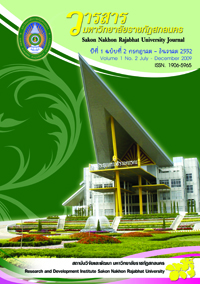ศึกษาการคายซับของเถ้าแกลบที่อิ่มตัว ด้วยสีย้อมผสมโลหะหนักที่มีพิษบางตัว
Abstract
บทคัดย่อ
วัตถุประสงค์ของงานวิจัยคือเพื่อศึกษาเถ้าแกลบอิ่มตัวด้วยสีผสมโลหะหนักที่มีพิษบางตัว ได้แก่ โครเมียม แคดเมียม ตะกั่ว และแมงกานีส ที่ใช้แล้วจากระบบบำบัดน้ำสีย้อม เพื่อนำมาใช้ ผสมเป็นมอร์ต้าร์แทนปูนซีเมนต์ได้ร้อยละ 20 และทำการทดสอบสมบัติทางกายภาพของเถ้าแกลบอิ่มตัวที่บด แล้ว ได้แก่ ค่าความถ่วงจำเพาะมีค่า 2.25 ปริมาณร้อยละการค้างบนตะแกรง 20-25 ค่าความละเอียด 8765-9050 ตารางเซนติเมตร/กรัม ความต้องการน้ำของมอร์ต้าร์ร้อยละ 112-114 และทดสอบกำลังอัดของมอร์ต้าร์มีค่า 250-255 กิโลกรัม/ตารางเซนติเมตร คิดเป็นร้อยละของกำลังอัดเมื่อเวลา 7 และ 28 วันเท่ากับ 79-83 ผลทดสอบ การคายซับจากเถ้าแกลบอิ่มตัวด้วยสารละลายกรดไนตริก 0.1 โมลาร์ จำนวน 15 ครั้ง พบว่าอัตราการ คายซับจะลดลงตามจำนวนครั้งและมีค่ามากที่สุดในครั้งแรก ให้ค่าปริมาณสีลดลงร้อยละ 4.32 โดยมวล และ โลหะลดลงอยู่ในช่วงร้อยละ 0.37-0.95 โดยมวล และเมื่อทดสอบการคายซับของมอร์ต้าร์ด้วยสารละลาย 8 ชนิด พบว่าค่าการคายซับมีค่าเพิ่มขึ้นตามเวลา และสารละลายโซเดียมคลอไรด์เข้มข้นร้อยละ 3 โดยมวลต่อ ปริมาตร มีประสิทธิภาพสูงสุดที่ทำให้สารหลุดออกมามากสุด ค่าปริมาณสี 0.92 มิลลิกรัม/ลิตร โลหะ โครเมียม 0.28 มิลลิกรัม/ลิตร แคดเมียม 0.16 มิลลิกรัม/ลิตร ตะกั่ว 0.87 มิลลิกรัม/ลิตร และแมงกานีส 0.07 มิลลิกรัม/ลิตร หรือคิดเป็นร้อยละ 1.07, 0.014, 0.008, 0.044 และ 0.004 ตามลำดับ ค่าสารที่หลุดออกมา ดังกล่าวไม่เกินมาตรฐานน้ำทิ้งโรงงานอุตสาหกรรม
Abstract
The objective of this work was to study the reuse of rice husk ash laden dye containing some toxic heavy metals such as chromium cadmium lead and manganese (laden RHA) from the dyeing treatment plant to replace 20% of ordinary Portland cement for making mortar. The grinding laden RHA was tested for physical properties. Specific, sieve analysis(%), fineness and water absorption were investigated with the results of 2.25, 20-25%, 8765-9050 cm2/g and 112-114% respectively. The strength of mortar was 250-255 Kg/cm2 or 79-83% of compressive strength for 7 and 28 days. The desorption process of laden RHA was investigated by using 0.1 nitric acid over 15 cycles. The rate of dye and metals which progressively declined in the subsequent batch cycles. It was concluded that the desorption efficiency at the first cycle decreased 4.32% for dye and 0.37- 0.95% for metals. The desorption behavior from mortar containing laden-RHA was tested by eight desorbing agents. The quality of desorpted dye and metals increased with increasing times. The 3% sodium chloride showed high efficiency for desorption of 0.92 mg/l (1.07%) for dye, 0.28 mg/l (0.014%) for chromium, 0.16 mg/l (0.08%) for cadmium, 0.87 mg/l (0.044%) for lead and 0.07 mg/l (0.004%) for manganese. It can be concluded that the data was not over the standard of industrial regulations.








